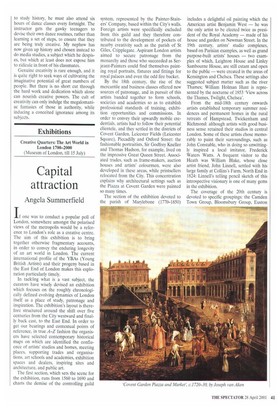Creative Quarters: The Art World in London 1700-2000 (Museum of London, till 15 July)
Capital attraction
Angela Summerfield
If one was to conduct a popular poll of London, somewhere amongst the polarised views of the metropolis would be a reference to London's role as a creative centre. The aim of this exhibition is to bring together otherwise fragmentary accounts, in order to convey the enduring longevity of an art world in London. The current international profile of the YBAs (Young British Artists) and their progeny based in the East End of London makes this exploration particularly timely.
In tackling what is a vast subject, the curators have wisely devised an exhibition which focuses on the roughly chronologically defined evolving dynamics of London itself as a place of study, patronage and inspiration. The exhibition's layout is therefore structured around the shift over five centuries from the City westward and finally back east, to the East End. In order to get our bearings and contextual points of reference, in true A-Z fashion the organisers have selected contemporary historical maps on which are identified the confluence of artists' studios and homes, meeting places, supporting trades and organisations, art schools and academies, exhibition spaces and dealers, inspiring sites and architecture, and public art.
The first section, which sets the scene for the exhibition, runs from 1560 to 1690 and charts the demise of the controlling guild system, represented by the Painter-Stainers' Company, based within the City's walls. Foreign artists were specifically excluded from this guild and they therefore contributed to the development of pockets of nearby creativity such as the parish of St Giles, Cripplegate. Aspirant London artists aimed to secure patronage from the monarchy and those who succeeded as Serjeant-Painters could find themselves painting royal portraits, fixtures and fittings for royal palaces and even the odd fire bucket.
By the 18th century, the rise of the mercantile and business classes offered new sources of patronage, and in pursuit of this artists banded together to form schools, societies and academies so as to establish professional standards of training, exhibition opportunities and commissions. In order to convey their upwardly mobile credentials, artists had to follow their potential clientele, and they settled in the districts of Covent Garden, Leicester Fields (Leicester Square), Piccadilly and Oxford Street: the fashionable portraitists, Sir Godfrey Kneller and Thomas Hudson, for example, lived on the impressive Great Queen Street. Associated trades, such as frame-makers, auction houses and artists' colourmen, were also developed in these areas, while printsellers relocated from the City. This concentration explains why architectural settings such as the Piazza at Covent Garden were painted so many times.
The section of the exhibition devoted to the parish of Marylebone (1770-1850) includes a delightful oil painting which the American artist Benjamin West — he was the only artist to be elected twice as president of the Royal Academy — made of his house and garden on Newman Street. In the 19th century, artists' studio complexes, based on Parisian examples, as well as grand purpose-built artists' houses — two examples of which, Leighton House and Linley Sambourne House, are still extant and open to the public — were created in the areas of Kensington and Chelsea. These settings also suggested subject matter such as the river Thames; William Holman Hunt is represented by the nocturne of 1853 'View across the Thames, Twilight, Chelsea'.
From the mid-18th century onwards artists established temporary summer residences and permanent homes in the rural retreats of Hampstead, Twickenham and Richmond: although artists with good business sense retained their studios in central London. Some of these artists chose memorably to paint their surroundings, such as John Constable, who in doing so unwittingly inspired a local imitator, Frederick Waters Watts. A frequent visitor to the Heath was William Blake, whose close artist friend, John Linnell, settled with his large family at Collins's Farm, North End in 1824: Linnell's telling pencil sketch of this introspective visionary is one of many gems in the exhibition.
The coverage of the 20th century is devoted to specific groupings: the Camden Town Group, Bloomsbury Group, Euston Road School, continental Hampstead, permissive Soho and the rise of the East End heralded by the artists-run Space and Acme studios. For those inspired to continue the journey, Tate Britain also offers 'a reconstitution' of Turner's Gallery. House and Library until 15 July.



































































 Previous page
Previous page